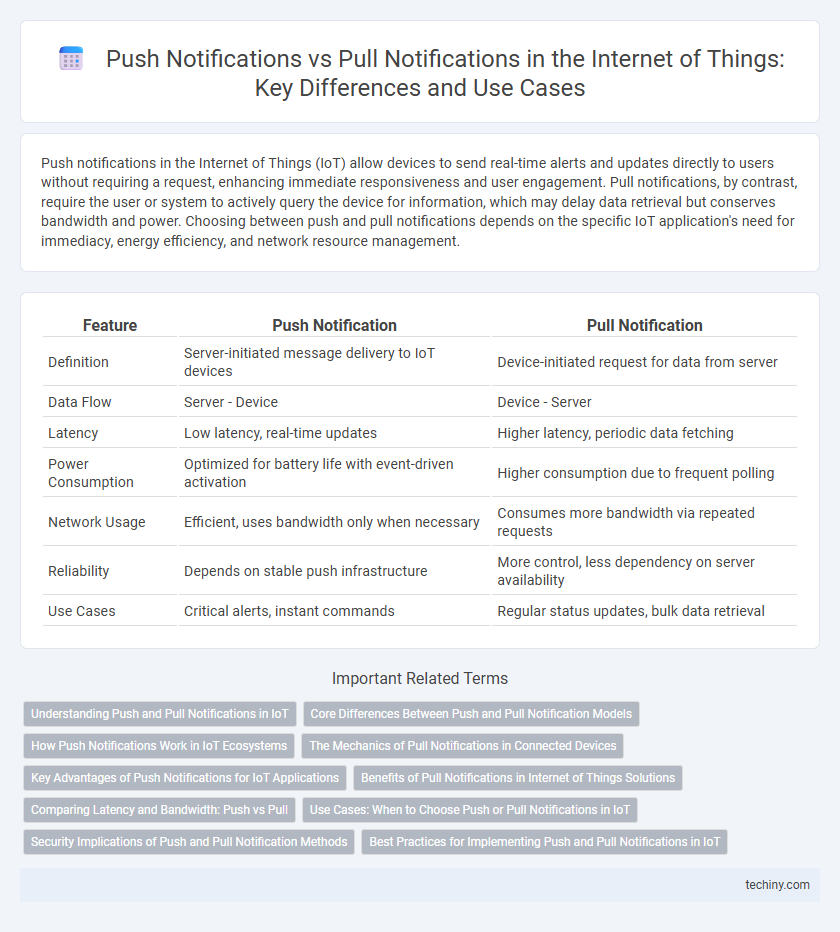Push notifications in the Internet of Things (IoT) allow devices to send real-time alerts and updates directly to users without requiring a request, enhancing immediate responsiveness and user engagement. Pull notifications, by contrast, require the user or system to actively query the device for information, which may delay data retrieval but conserves bandwidth and power. Choosing between push and pull notifications depends on the specific IoT application's need for immediacy, energy efficiency, and network resource management.
Table of Comparison
| Feature | Push Notification | Pull Notification |
|---|---|---|
| Definition | Server-initiated message delivery to IoT devices | Device-initiated request for data from server |
| Data Flow | Server - Device | Device - Server |
| Latency | Low latency, real-time updates | Higher latency, periodic data fetching |
| Power Consumption | Optimized for battery life with event-driven activation | Higher consumption due to frequent polling |
| Network Usage | Efficient, uses bandwidth only when necessary | Consumes more bandwidth via repeated requests |
| Reliability | Depends on stable push infrastructure | More control, less dependency on server availability |
| Use Cases | Critical alerts, instant commands | Regular status updates, bulk data retrieval |
Understanding Push and Pull Notifications in IoT
Push notifications in IoT enable devices to receive real-time alerts and updates directly from servers, enhancing responsiveness and immediate action. Pull notifications require devices to request data periodically, which can lead to increased latency and higher energy consumption due to constant polling. Understanding the trade-offs between push and pull mechanisms is crucial for optimizing network efficiency and power management in IoT systems.
Core Differences Between Push and Pull Notification Models
Push notifications actively deliver real-time alerts from IoT devices to users without requiring a request, optimizing immediate data transmission and energy efficiency. Pull notifications depend on users or systems to request updates from IoT sensors, which can introduce latency and increase network traffic due to repeated polling. The core difference lies in data flow direction and communication initiation, with push models enhancing responsiveness and pull models offering on-demand control in IoT environments.
How Push Notifications Work in IoT Ecosystems
Push notifications in IoT ecosystems operate by servers or cloud platforms sending real-time alerts or updates directly to connected devices without requiring a device-initiated request. These notifications leverage protocols such as MQTT or CoAP to ensure efficient, low-latency communication tailored for the constrained resources typical of IoT devices. This method enhances proactive device management and timely data transmission, crucial for applications like smart home security, industrial monitoring, and healthcare alert systems.
The Mechanics of Pull Notifications in Connected Devices
Pull notifications in connected devices operate by having the device periodically query a server or data source for updates, ensuring the device initiates the communication. This method reduces immediate network traffic by limiting data exchanges to predefined intervals, which can conserve battery life and bandwidth in IoT applications. Unlike push notifications, pull mechanisms rely on the device's schedule, potentially introducing delays in receiving critical data in real-time IoT environments.
Key Advantages of Push Notifications for IoT Applications
Push notifications in IoT applications offer real-time data delivery, ensuring instant updates for critical device monitoring and control. They reduce power consumption and bandwidth usage by eliminating the need for constant polling, enhancing overall system efficiency. Enhanced user engagement and timely alerts improve response times and facilitate proactive maintenance in connected environments.
Benefits of Pull Notifications in Internet of Things Solutions
Pull notifications in Internet of Things (IoT) solutions enable devices to request data on-demand, enhancing control over network traffic and reducing unnecessary power consumption. This method improves security by minimizing unsolicited data transmissions, making it ideal for battery-powered IoT devices operating in sensitive environments. Pull mechanisms also facilitate efficient synchronization and real-time data retrieval, supporting scalable and reliable IoT ecosystems.
Comparing Latency and Bandwidth: Push vs Pull
Push notifications offer lower latency by delivering data instantly from IoT devices to end users, reducing the need for constant polling. Pull notifications, relying on periodic device requests, increase latency and consume more bandwidth due to repeated data fetching. Optimizing IoT communication protocols with push mechanisms enhances real-time responsiveness and bandwidth efficiency compared to pull-based methods.
Use Cases: When to Choose Push or Pull Notifications in IoT
Push notifications in IoT are ideal for urgent updates such as security alerts, device malfunctions, or real-time sensor data that require immediate user attention. Pull notifications work best for non-critical information like routine status checks, periodic data retrieval, or user-initiated requests where timely delivery is less crucial. Choosing between push and pull depends on factors like network bandwidth, device power consumption, and the urgency of the data being transmitted.
Security Implications of Push and Pull Notification Methods
Push notification methods in the Internet of Things (IoT) raise security concerns due to their continuous device communication, increasing the attack surface for unauthorized data interception or malicious payload delivery. Pull notification models provide enhanced security by requiring the IoT device to initiate communication, reducing exposure to unsolicited data and enabling stronger access control and authentication mechanisms. However, the trade-off involves balancing real-time data needs against the reduced risk of cyber threats inherent in pull-based systems.
Best Practices for Implementing Push and Pull Notifications in IoT
Implementing push and pull notifications in IoT systems requires prioritizing low latency and efficient bandwidth usage to optimize device responsiveness and power consumption. Best practices include utilizing MQTT or CoAP protocols for push notifications to ensure real-time data delivery, while pull notifications should leverage RESTful APIs with caching strategies to reduce server load. Security measures such as end-to-end encryption and token-based authentication are critical to protect sensitive IoT data during both push and pull communication.
Push notification vs Pull notification Infographic

 techiny.com
techiny.com